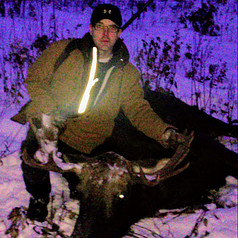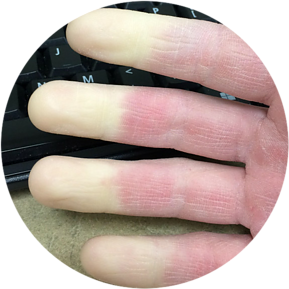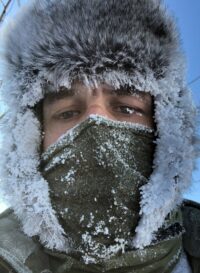As someone with Raynaud’s Phenomenon, I have Google’d ” How to Keep Warm While Hunting ” many, many times over the years. This is my chance to help you save time with search engines and let you spend more time in the bush or field. I will summarize what I have learned that works, and what doesn’t work.
This article will talk about a couple of different conditions that may lead to the feeling of being cold while hunting. I will also give a few suggestions on how to keep warm while hunting. These concepts apply whether your situation is simply because of the temperature, or from an underlying condition.
The key elements we will address are: clothing materials and layers, health in general and activity levels, conditioning yourself to the cold, and possible supplements.
How to Keep Warm While Hunting – Through Clothing
Materials
Cotton:
The first thing to keep in mind is the materials of your clothing. In general synthetic fabrics are going to be a good option for winter/cold weather clothing. The reason I make this statement is because most people when they think of natural fabrics think of cotton. Many shirts, pants and socks are cotton based (even jeans).
Clothing made from cottons are quite nice when the weather is nice. Unfortunately, cottons retain moisture and that moisture then causes the material to become heavy and cold in winter environments. That cold stays against your body and the added moisture will make your body temperature drop quicker. Another drawback is that due to the retained moisture, items like socks will become heavy and start to crease with movement. This will lead to blisters pretty quickly.
Wool, Silk, Hemp:
These three materials are natural materials. Usually people think of wool for warmth, but most people don’t immediately think of silk or hemp for winter clothing.
Silk would not be my first choice, but the advantages to this over cotton are apparent. Silk has moderate wicking capabilities, and is quite soft. Given these properties you could use silk as a base layer.
Hemp is newer to the clothing market. This material is stronger than its cotton comparisons. Hemp is also odor resistant, soft to the touch, and capable of wicking moisture. Due to the structure of the fibers it is also effective at helping to regulate body temperature. The issue comes into play when the material gets wet. As with most plant based products hemp conducts heat away from the body when wet.
Wool is a great product that has been trusted for pretty much as long as anyone can remember. The stereotype of it being itchy has started to diminish thanks to new manufacturing techniques and different structures of wool (example: Merino wool vs Traditional wool). The great thing about wool is that it doesn’t conduct heat away from the body very effectively when it is wet. As a result wool is known to keep you warm, even when it is wet.
Some products now use finer wool (Merino wool) and/or add synthetic fibers to increase the products wicking capabilities.
Synthetics:
This category covers all sorts of options – so I will talk about them in general. Synthetic materials are often designed with specific purposes in mind. For example cold weather activities, etc. Many synthetic fibers are made to be soft to the touch, and hydrophobic on the inside. This causes the material to wick moisture away very efficiently. That wicking effect then allows for a thinner layer of moisture on the material which then evaporates much quicker, allowing you to stay dry.
Many manufacturers have also been able to develop manufacturing processes that allow for small air pockets to be present in the materials. These air pockets will then warm with your body heat and retain that heat, helping you to regulate your body temperature over a longer period. This is similar to how a wet suit helps divers. A layer of water enters the suit and stays between the diver and the neoprene. That water then warms with the diver’s body heat, and since it stays in contact with the diver, helps to maintain the body temperature of the diver.
Fleece and Thinsulate are two terms you should become familiar with when it comes to synthetics. Fleece is a material structure that many companies make and use, whereas Thinsulate is a trademark owned by 3M. These two synthetics will become some of your main warmth building items.
There are many other materials both natural and synthetic, but the above items give us enough of a starting point to keep most people warm.
Layering:

The next thing you want to know is that the key to warmth is not wearing a big coat (putting all your eggs in one basket). The key to warmth is layering.
You want to have three main layers. A base layer, a middle layer, and an outer layer.
Base Layers
The layer that would be in direct contact with your skin. This layer should be somewhat fitted against your skin and provide a basic level of warmth. The reason they need to be fitted against your skin, is so that they can wick away any moisture which will help you stay warm in the long run. The base layer needs to be a material that wicks moisture, as well as one that does not conduct heat away from the body when it is wet. Examples would be wool (Merino wool is softer on the skin) and fleece or Thinsulate materials.
Middle Layers
This is anything between your base layer and outer layer. So in theory you can have more than one middle layer in your set-up. I personally have usually two middle layers which I will provide a reason for later in this blog. This layer is the layer that you want to have the bulk of your warmth providing materials in. Keep in mind that it is still a positive to have something that will wick moisture, or at the very least retain its warmth when it is wet. I usually stick to the same materials as a base layer, except much thicker. This layer is also not tight against the body. We want some air in this area to help wick the moisture from the base layer, and also trapped air acts as an insulator as well.
Outer Layers
Are the last line of defense between you and the elements. This layer usually is not meant to provide a lot of warmth, but instead is meant to fend off the two main elements that cause you to have a drop in body temperature. This layer is like a shell or membrane to keep the wind and rain/moisture away from your other layers. The key here is that the outer layer has to breathe. The heat and moisture you generate under this layer needs to be able to escape and/or evaporate, while the outer layer keeps the outside elements outside. This can be accomplished with many synthetic materials which have been built to breathe in a single direction (technology is great, even if we over simplify the description), or clothing that has venting built in strategically to allow airflow.
For my outer layer, if it is not too cold or wet, I will use tightly woven natural fibers. When the wind is strong, or there is a chance of rain or snow, I am moving into synthetics made from nylon (you may hear many people talk about the advantages of Gore-Tex as an outer layer).
Hands and Feet
I will start off by saying, I cheat a little bit. I use a ZIPPO 12 Hour Hand Warmer to help with my fingers due to my medical condition. I talk about that device and its benefits in another post which can be accessed here: ZIPPO 12 Hour Hand Warmer Review
Hands and feet are going to be similar to the needs of the rest of your body except possibly missing a layer (usually just the hands). For your feet you want a base sock that will provide a little warmth, but capable of moisture wicking. You will then have a second sock that is a little looser and provides the base of the warmth. Your outer layer is going to be your boot. With boots you will see many advertisements about warmth, and Thinsulate is a prominent material in the insulation of boots.
Keep in mind the Thinsulate numbers can be almost nothing, up to around 1000gr. The higher the gr. the warmer the boot, but also the bulkier and less flexible. So for example a 1000gr boot would be a good choice for sitting in a cold blind or tree stand, but not very convenient for someone that does a lot of spot and stalk.
Your hands are a little trickier. Usually a base layer glove is a great option. Then depending on your level of cold tolerance, either an insulated outer layer glove or mitt. Mitts are much warmer than gloves. Since I suffer from Raynauds, I use a Lobster or trigger finger glove in the extreme cold. I basically keep all my fingers together like a mitt, and if I hear or see something, I slide my index finger into its separate finger slot which allows me to access my trigger without having to remove the entire mitt. This means I can wait longer if necessary to get the best shot.
Extremities
Make sure also look at covering your neck and head. Typically these areas are more exposed, and as a result they are the reason for a larger portion of our heat loss.
How to Keep Warm While Hunting – Impacts of Health and Activity Level

As I mentioned, I have Raynaud’s Syndrome. This is a condition where the body overreacts to certain stimuli (typically the cold). This overreaction leads the body to believe that it is going to go into hypothermia and as a result the body stops sending blood to the extremities in an attempt to pool the blood around the internal organs to keep them warm. Sound fun yet? Well wait until you here this. It doesn’t take extreme temperatures to trigger the response. If I am in a warm car and step outside to temperatures just above freezing, my hands and feet will be impacted.
Not only will a sudden change in temperature cause this to happen, but also prolonged exposure to the cold. If I am outside and start to get cold over time, my body will then react and start restricting blood to my extremities. This cause lack of mobility and feeling in those parts of the body, but also extreme pain when I start to warm up and the blood flows back into the affected areas.
There are several other factors or conditions that can affect a person’s ability to regulate body heat. Some examples are: medications, thyroid issues, anorexia, diabetes, alcohol consumption, etc. If you have medical issues that cause body heat regulation issues, I would suggest that you speak with your doctor as they may be able to prescribe medications to help with circulation.
Aside from seeking medical help, the other key element if you have an underlying condition, is to try to avoid the triggers. In my case, the trigger is the body believing it needs to protect the internal organs, and quite frankly that is similar to other issues. When the body gets cold, it restricts blood flow. You need to try to keep the blood flow optimal so that your extremities won’t be deprived.
What I do to counter this effect, is I try to keep my body just slightly on the hot side. I wear my base layer a mid layer for extreme warmth, I then usually tac on another mid layer that would be a vest of long sleeve, followed by my outer layer. This keeps my core slightly hot, which tends to prolong my ability to be in the cold before my body then decides I am getting too cold.
Level of Fitness
Another thing to keep in mind is that if there are no medical conditions impacting your body heat regulation, then your level of fitness would have a significant impact on its own. There are multiple types of fat that a human body may have, and unfortunately the fat that makes us nice and cuddly is not the type of fat that helps us stay warm. People have Brown fat and White fat. Usually adults don’t have much Brown fat by percentage compared to when they were children. Brown fat does have the benefit of storing energy and therefore being able to generate heat. This is often triggered by hormone releases. Fortunately, your body produces the correct hormone when it gets cold.
White fat is more for storing extra calories that were consumed for times when we may not have enough food and need extra fuel. Studies indicate that people with a lean body composition tend to have more brown fat than someone that is overweight. So, being physically fit without underlying medical conditions will put you in a better position to counter the cold.
When we look at level of activity, you need to learn how to balance this. You need to be active enough that your body generates heat through calorie burning (this is what happens when you shiver, so Let’s do it without the discomfort of shivering). The tricky part is that while you are being active to generate heat, you need to make sure you are not active enough to generate sweat. As we have talked about previously, moisture is your enemy when it comes to staying warm.
When you are being active, make sure not to overexert yourself, and take breaks as necessary to make sure you don’t overheat. A few moments of the joy from overheating is not worth the consequences you will face from the sweat you will create.
Conditioning Yourself to the Cold
This is a little simpler than it sounds. Think about the cold as simply a matter of perspective. I live in northern Canada. In the spring when it is 1 or 2 degrees above freezing I will be out in a t-shirt and enjoying the weather. That same temperature in early fall and I am pulling on a sweater. This is because in the spring I have just endured a very long winter with temperatures probably getting down to -40 or worse from time to time. So quite frankly just above freezing is quite pleasant. That same temperature after a nice summer is chilly.
Conditioning yourself to something is basically just exposing yourself to it repeatedly, until it seems normal. With regard to the cold, this can be done by keeping your home a little colder (even by a couple of degrees). Taking colder showers daily. Not putting on the sweaters when the temp drops a degree or two, and not cranking the heat in the car during the winter.
You will also benefit from getting outside, even for shorter periods, when you are exposed to brisk temperatures.
These approaches to increasing your tolerance levels will go hand in hand with some good’ole mind over matter. You need to focus on the actual temperature, or the heat/warmth you are generating or receiving from your clothes. Focusing on those items instead of how cold you “feel” will make temperatures seem more tolerable.
The thing to keep in mind is that people have become reliant on environmental manipulation when it comes to heat and air conditioning. In places where A/C is not as prevalent, people seem more tolerant to heat. In places where heating is not available, or is overly expensive, people seem more tolerant to cold. The goal is for you to get your body back to the basics of regulating itself, instead of relying on environmental controls.
How to Keep Warm While Hunting – Through Supplements and Food
Disclaimer: I am not a doctor or health care professional. Before you take any vitamins or supplements it is recommended that you check with you personal Doctor.
There, now that is out of the way, I will share a few things I have discovered during my own research. Just little things you may want to look into yourself.
Some vitamin and mineral deficiencies are suspected to be linked to feeling cold. The two main culprits seem to be Iron and vitamin B12. These items are involved in red blood cell production, etc. so if you have low levels of either your red blood cell production and circulation could be affected.
When looking at food or herbal supplements you will want to look at a few things. Caffeine helps increase your metabolism which will help you keep warm. Do not overdo it though, as too much caffeine can have the opposite effect when it comes to feeling warm.
Some people will tell you that spicy food will help you stay warm. Well, that is a bit misleading. Spicy food will warm you up while you are eating it, but if it is too spicy you will sweat, and we know what moisture does. The act of eating itself causes a warming effect as your body starts to break down the food you just ate.
The reason people seem to think spicy food warms you up is because you need thermogenic foods (foods that increase your metabolism). Certain foods that we think of as spicy have these properties. Capsacin, for example, is in hot peppers, and is responsible for a thermogenic response. Foods like black pepper also have thermogenic properties without the same spice factor as a hot pepper.
Foods high in protein, coconut oil, green tea, ginger, and turmeric are all example of sources that can create a thermogenic reaction. Ginkgo Biloba which is found as a supplement, similar to the way you can find turmeric, is supposed to help with blood flow.
When it comes to diet and supplements to help you keep warm, I would suggest you look at items that create thermogenic responses or support proper blood flow.
Staying Warm While Hunting – Putting it all Together
In summary this is a process which will involve trial and error based on your personal situation. The short catch-all is to say, use wool or technical fabrics in a layering combination. Adjusting the amount of mid layers necessary to have you feeling just slightly on the warmer side. Make sure to use layering techniques for your hands and feet as well, without forgetting to cover your neck and head.
Talk to your doctor and address any underlying medical conditions that may not contribute to sufficient body heat regulation. Medications may be necessary, or the opposite may exist, where the medications you are on are preventing proper body heat regulation.
Get yourself in shape, and stay active in general. This will help all year, and staying active while hunting will help maintain a level of warmth. Just remember don’t sweat.
Finally, start exposing yourself to the cold, and just let your body get used to it. This combined with eating foods that increase metabolism will have your body generating heat in no time.
Remember, frostbite, and hypothermia are very serious and potentially dangerous conditions. If your attempt to stay warm seems to be failing you, then call it a day, and get out of the bush. Go back to a warm car for a while, or even your house.
A tip on warming your fingers is to put them under your arms, or between your legs. Don’t blow on them! Remember your breath is moist and we know that moisture is our enemy.
Keep Smart and Hunt On – and of course Stay Warm
Scott

